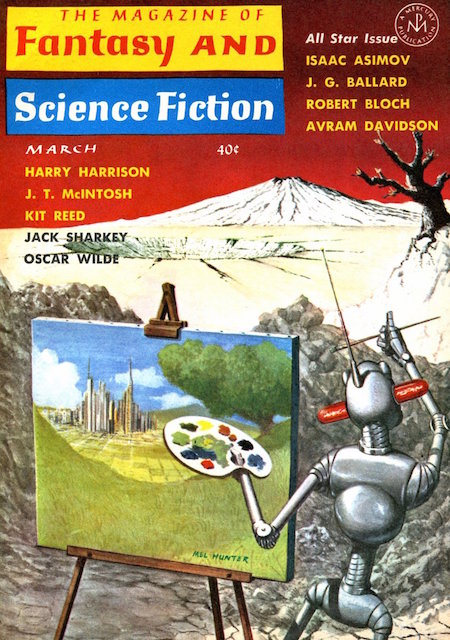Science Fiction
Dictionary
A B C D E F G H I J K L M N O P Q R S T U V W X Y Z
String Art Courtesy Of Robot Artist

Remember this iconic scene from the movie version of Isaac Asimov's 1950's classic I, Robot?
("No, I can't create great art" Sonny, I, Robot)
A recent art project experiment at TU Wien in Austria comes pretty close.
The basic idea of string art is simple: hooks distributed on a frame are connected by strings back and forth until they fuse to a perceptible image.At TU Wien (Vienna), this kind of creation of artistic images has now been automated: the computer calculates the optimal thread path from an arbitrary given image and an industrial robot then takes over the job of arranging the thread.
"From a scientific point of view, this is a very interesting problem because it is particularly difficult to solve," says Przemyslaw Musialski from the Institute for Discrete Mathematics and Geometry at TU Wien. In general, a picture cannot be exactly reproduced in this way - after all, the thread method cannot be used to set individual pixels, but only to draw continuous lines. It is therefore necessary to find the best possible approximation.
This is a challenge: the number of different ways to span a thread between a larger number of hooks is astronomical. It is completely impossible to try all conceivable variants. "This task belongs to the so-called NP-hard problems," says Musialski. "This is the class of computing problems that cannot be solved accurately by computers in a reasonable amount of time."
To create the image, a circular frame with 256 hooks is used. "Our calculations have shown that increasing the number of hooks any further improves the final result only marginally," says Przemyslaw Musialski.
(Via TU Wien.)
(String art by computer and robot)
I'd also add this creative cover art by Mel Hunter from Fantasy and Science Fiction of March, 1964:

(Robot artist cover graphic, 1964)
Scroll down for more stories in the same category. (Story submitted 9/15/2018)
Follow this kind of news @Technovelgy.| Email | RSS | Blog It | Stumble | del.icio.us | Digg | Reddit |
Would
you like to contribute a story tip?
It's easy:
Get the URL of the story, and the related sf author, and add
it here.
Comment/Join discussion ( 0 )
Related News Stories - (" Computer ")
Is Agentic AI The Wrong Kind Of Smartness?
'It’s smart enough to go wrong in very complicated ways, but not smart enough to help us find out what’s wrong.' - Isaac Asimov, 1975.
Jetson Orin Nano Super 70 Just $249
'Rayno folded up the microterm and tucked it back inside his jumper.' - Bruce Bethke, 1983.
Automatic Bot Traffic Is 38 Percent Of HTTP Requests
'there were so many worms and counterworms loose in the data-net...' - John Brunner, 1975
Neuroplatform Human Brain Organoid Bioprocessor Uses Less Electricity
'Cultured brains on a slab.'- Peter Watts, 1999
Technovelgy (that's tech-novel-gee!) is devoted to the creative science inventions and ideas of sf authors. Look for the Invention Category that interests you, the Glossary, the Invention Timeline, or see what's New.
Science Fiction
Timeline
1600-1899
1900-1939
1940's 1950's
1960's 1970's
1980's 1990's
2000's 2010's
Current News
Natural Gait With Prosthetic Connected To Nervous System
'The leg was to function, in a way, as a servo-mechanism operated by Larry’s brain...'
Woman Marries Computer, Vonnegut's Dream Comes True
'Men are made of protoplasm... Lasts forever.'
Spidery 'Walk Me' Toyota Autonomous Wheel Chair Like Star Wars
Walk along with the emperor.
Dancing Robots Taught Dance Moves
'A clockwork figure would be the thing for you...'
Proof Of Robothood - Not A Person
'Who are you people? - Show 'em.'
Indonesian Clans Battle
'The observation vehicle was of that peculiar variety used in conveying a large number of people across rough terrain.'
The 'Last Mile' In China Crowded With Delivery Robots
Yes, it's a delivery robot. On wheels.
Tornyol Microdrone Kills Mosquitoes
'The real border was defended by... a swarm of quasi-independent aerostats.'
PLATO Spacecraft, Hunter Of Habitable Planets, Now Ready
'I ... set my automatic astronomical instruments to searching for a habitable planet.'
Factory Humanoid Robots Built By Humanoid Robots
'...haven't you a section of the factory where only robot labor is employed?'
iPhone Air Fulfils Jobs' Promise From 2007 - A Giant Screen!
'... oblongs were all over the floor and surfaces.'
ChatGPT Now Participates in Group Chats
'...the city was their laboratory in human psychology.'
iPhone Pocket All Sold Out!
'A long, strong, slender net...'
Did The Yautja Have These First?
What a marvel of ingenuity the little device was!
Jetson ONE Air Races Begin, Can Air Polo Be Far Behind?
'If you're one of those rarities who haven't attended a rocket-polo "carnage", let me tell you it's a colorful affair.'
Will Space Stations Have Large Interior Spaces Again?
'They filed clumsily into the battleroom, like children in a swimming pool for the first time, clinging to the handholds along the side.'
